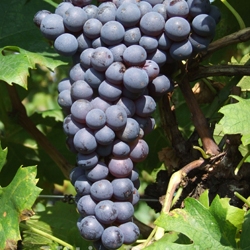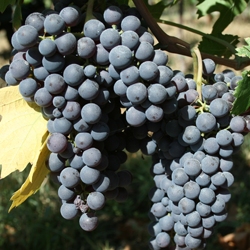

Zona di produzione
Nestled between the Adige River in the west, the city of Verona to the south, and the Lessinia to the north, Valpolicella is the land that gives rise to some of the greatest Italian red wines. The first Consortium for the Protection of wine dates back to 1925. The heart of production, which is identified as the “Valpolicella Classico”, includes the municipalities of Marano, Fumane, Negrar, Sant’Ambrogio and San Pietro in Cariano, some of which give rise to the three main valleys of Fumane, Marano and Negrar. In contrast to this is the so-called “typical” area in the most eastern part of the denomination which, in addition to Valpantena (the only recognised sub-zone), refers also to the valleys of Marcellise, Mezzane, Illasi, and Tramigna. Altogether there are 19 municipalities included in whole or in part in the D.O.C., extending into the hills which range from 150 to 600 meters above sea level. In 2010 he Amarone and Recioto gained the DOCG, the controlled and guaranteed denomination of origin.
Caratteristiche e tipologie vino
The splendid microclimate of Valpolicella, where the warm breezes from the Garda Lake meet the fresh air of the Lessini Mountains, favours the production of great red wines such as Amarone, one of the Italian red wines of honour appreciated by the most demanding consumers throughout the world, which is born from the evolution of Recioto. The production technique has been unchanged for centuries: the grapes are harvested between the last ten days of September and the first week of October, selected perfectly sound and ripe so that they can successfully tackle the delicate phase of withering which lasts 100 days. Following this the grapes are pressed and the resulting wine is aged in barrel and in bottle, a process that can last for several years. Before release for consumption the Amarone must be subjected to an aging period of at least two years, which become four for the “Reserve”. The Valpolicella “Ripasso” takes its name from the particular processing technique, which involves a maceration of Valpolicella wine on marc of fermented grapes previously used for the production of Recioto or Amarone. The must-wine is racked and the marc, still in partial fermentation, is drained in a more or less intense static manner into the fermentation vat, where Valpolicella wine obtained from fresh grapes is added. The result is a wine with more alcohol, with a lower acidity, a greater roundness and a higher value in extracts. The Valpolicella Superiore differs compared to the Valpolicella for its higher alcohol content, lower acidity, greater roundness, and a more high-value extract, thanks to an aging of at least one year.
Grapes
-

RONDINELLA
-

CORVINA VERONESE
-

CORVINONE
Corvina, Corvinone, Rondinella, Molinara, but also Cruina, Forselina, Negrara, Oseleta: these are the autochthonous varieties on which wine production is concentrated. The most important is the Corvina (especially appreciated for its range of colouring substances, its concentration, and its great capacity to adapt to withering), which gives the wines of Valpolicella an unmistakable note of cherry. Corvina can enter into the composition of vineyards for up to 80%. Long considered one of the many varieties of Corvina, Corvinone is actually a vine in itself that in the best vintages can reveal superior organoleptic characteristics. It can enter into the composition of vineyards for up to 40%, in replacement of an equal percentage of Corvina. Rondinella can enter into the composition of vineyards for up to 30%. It seems that the name derives from the colour of the skin, which recalls the livery of swallows. It’s a variety which arrived in the province of Verona in the 19th century. According to the rules of production other non-aromatic red grape varieties may also contribute, up to a maximum of 15% total and within the limit of 10% for each single vine used. These are the historical varieties typical of the Verona province that have been utilised in recent years such as Molinara, Dindarella and Oseleta, but also varieties of more recent introduction such as Sangiovese, Cabernet Franc, Cabernet Sauvignon, Merlot, and Teroldego.
Red Wines
AMARONE DELLA VALPOLICELLA D.O.C.G.
Colour: rosso rubino carico tendente eventualmente al granato con l’invecchiamento;
Bouquet: caratteristico, accentuato, di ciliegia, ribes, cioccolato e spezie;
Taste: pieno, vellutato, caldo;
Alcoholic Strength minimum total volume: 14% vol. con residuo alcolometrico volumico potenziale massimo di 0,7% vol.;
Accompaniments: è un vino robusto, ideale per arrosti di cacciagione da pelo o selvaggina nobile di piuma e formaggi stagionati;
Note particolari: il vino presenta anche le specificazioni le “Classico”, “Valpantena” e “Riserva”. Quest’ultima si distingue per un maggiore estratto secco minimo, di 35 g/l. Il disciplinare di produzione vigente prevede che l’uvaggio sia composto da uve Corvina (dal 40% al 80%), è tuttavia ammesso in tale ambito la presenza del Corvinone nella misura massima del 50%, in sostituzione di una pari percentuale di Corvina, Rondinella dal 5% al 30%. Possono concorrere i “vitigni a bacca rossa non aromatici, autorizzati e raccomandati per la provincia di Verona”, previsti, sino ad un massimo del 15%, dalla D.O.C.. Mantiene le sue caratteristiche anche per 10-20 anni.
RECIOTO DELLA VALPOLICELLA D.O.C.G.
Colour: rosso rubino carico tendente eventualmente al granato con l’invecchiamento;
Bouquet: caratteristico, accentuato;
Taste: pieno, vellutato, caldo, delicato, dolce;
Alcoholic Strength minimum total volume: 12% vol. con un residuo alcolometrico volumico potenziale minimo di 2,8% vol.;
Accompaniments: è un vino amabile e dolce, che ben si presta a numerosi abbinamenti con i dessert e con i piatti nei quali predomina l’uso della pasta frolla;
Note particolari: presenta anche le specificazioni “Classico” e “Valpantena” e “Riserva”. Il nome deriva infatti dal termine dialettale «recie» che richiama il latino recis, e si riferisce ai grappoli spargoli e maturi selezionati per questo vino. L’appassimento varia da 50 a 120 giorni a seconda delle condizioni climatiche e della qualità delle uve.
VALPOLICELLA
Colour: ruby red, tending to garnet with aging
Bouquet: vinoso con profumo gradevole, delicato, caratteristico, che ricorda talvolta le mandorle amare;
Taste: vellutato, di corpo, sapido, armonico;
Alcoholic Strength minimum total volume: 11% vol, con un residuo alcolometrico volumico potenziale massimo di 0,4 % vol.;
Accompaniments: a tavola si sposa con tutti i tipi di carni bianche, nelle diverse preparazioni, e con una vasta gamma di formaggi, sia freschi che stagionati;
Note particolari: si presenta anche con le denominazioni anche con le specificazioni “Classico”e “Valpantena”.
VALPOLICELLA RIPASSO
Colour: rosso rubino carico tendente al granato con l’invecchiamento;
Bouquet: caratteristico con profumo gradevole;
Taste: pieno, vellutato, di corpo;
Alcoholic Strength minimum total volume: 12,5% vol., 13% vol., per la categoria “Superiore”;
Accompaniments: è ideale negli abbinamenti con piatti corposi e robusti come la selvaggina oppure gli con arrosti;
Note particolari: si presenta anche con le denominazioni anche con le specificazioni “Classico”, “Superiore” e “Valpantena”. Si distingue per la particolare tecnica del “ripasso”, che consiste nel far riferimentare del vino con vinacce fermentate di uve appassite precedentemente utilizzate per la produzione del Recioto o dell’Amarone. Alla svinatura del mosto-vino, dopo aver sgrondato staticamente in maniera più o meno intensa le vinacce nel tino di fermentazione, si pone del vino Valpolicella ottenuto da uve fresche nel medesimo recipiente a contatto con le vinacce ancora in parziale fermentazione. Ne nasce un vino caratterizzato da una maggior struttura e longevità rispetto al Valpolicella, da una maggiore alcolicità, da una acidità più bassa e una maggior rotondità, da un più elevato valore in estratti e in sostanze fenoliche, idoneo ad avvantaggiarsi dell’invecchiamento minimo di un anno previsto dal disciplinare.
VALPOLICELLA SUPERIORE
Colour: ruby red, tending to garnet with aging
Bouquet: vinoso con profumo gradevole, delicato, caratteristico, che ricorda talvolta le mandorle amare;
Taste: vellutato, di corpo, sapido, armonico;
Alcoholic Strength minimum total volume: 12% vol, con un residuo alcolometrico volumico potenziale massimo di 0,4% vol.;
Accompaniments: va abbinato per lo più con secondo piatti a base di selvaggina oppure con gli arrosti.

